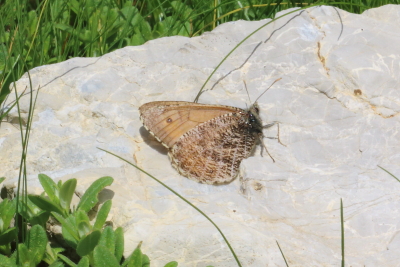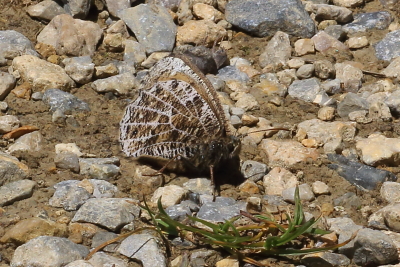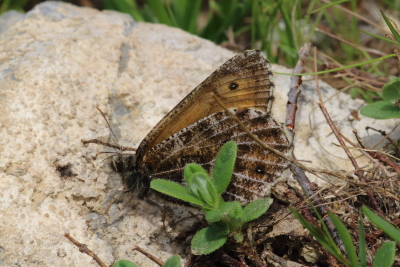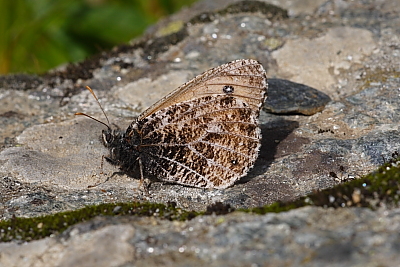Alpine Grayling (Oeneis glacialis)
2024 photographs highlighted in yellow. Click on any photograph to go to an enlarged picture, or simply scroll down the page.
 |
 |
 |
|
| 45362_male_Hautes-Alpes_6Jul18 | 53115_male_Hautes-Alpes_15Jul24 | 45363_female_Hautes-Alpes_6Jul18 |
31180_female_Valais, Switzerland_12Jul12 |
|
A butterfly of high altitudes, with a fairly early flight period. It is the only species of grayling to occur at high altitudes, so impossible to confuse with any of its Hipparchia cousins (not that glacialis is of the genus Hipparchia), although if the forewing is not visible (and it never settles with open wings) it is superficially similar to one or two of the Erebia ringlets, principally the Marbled Ringlet (Erebia montana). |
My understanding is that glacialis has a two-year cycle, and in France only occurs (or is significantly less infrequent) in even-numbered years, whereas in eastern Switzerland this is the case for odd-numbered years.
Whether this is true, and to what extent, is not clear. I plan to revisit the same location in 2019 to ascertain whether glacialis can be seen there in an odd-numbered year. 2019 footnote: I did revisit the site but did not see glacialis, so maybe the received wisdom is true. |
|
ref |
sex |
observations |
alt. m |
| 45362 | M | a male, based on the paler markings and smaller ocellus. It was in company with 45363 and the two descended from a steep rocky scree only intermittently (i.e. on only two occasions in three hours - some degree of dedication is required for this species). Its behaviour seemed entirely normal and its rather odd-looking flat pose on this rock did not seem to indicate that there was anything wrong with it. | 2370 |
| 53115 | M | I believe this to be a male as it was taking salts from the ground. This is a distance shot, as my attempt to get closer met with failure. | 1830 |
| 45363 | F | a female, seen in company with 45362. I am assuming that it is a female based on the stronger markings and colouring. It settled, inevitably, on the rock immediately behind a sprig of vegetation and a twig; this is a familiar dilemma - take the photograph as it is (which I did) or attempt to move the vegetation and risk losing the shot. I have found through experience that it is best to take the shot first and then, and only then, to try to remove the vegetation. This is what I did, and the resultant absence of a clear photograph indicates the success of the attempt to move the vegetation. | 2370 |
|
31180 |
F |
a female, based on size, wing shape, markings and the fact that it appeared to be at the end of the flight period. However, this is the only glacialis I have ever seen (as at 2012), so this is based on a very limited perspective. |
2090 |
45362_male_Hautes-Alpes_6Jul18
53115_male_Hautes-Alpes_15Jul24
45363_female_Hautes-Alpes_6Jul18




